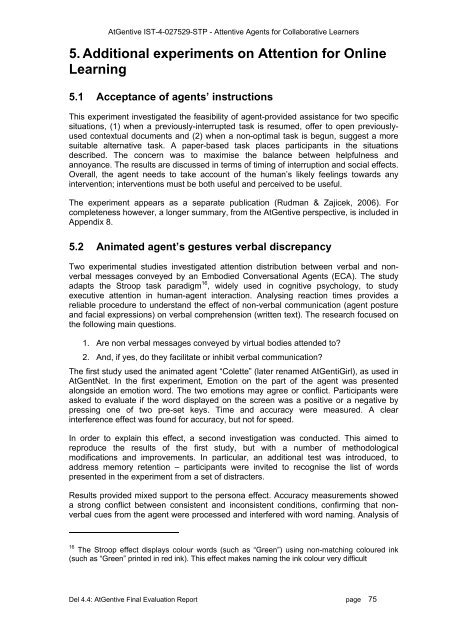Deliverable 4.4 - INSEAD CALT
Deliverable 4.4 - INSEAD CALT
Deliverable 4.4 - INSEAD CALT
Create successful ePaper yourself
Turn your PDF publications into a flip-book with our unique Google optimized e-Paper software.
AtGentive IST-4-027529-STP - Attentive Agents for Collaborative Learners5. Additional experiments on Attention for OnlineLearning5.1 Acceptance of agents’ instructionsThis experiment investigated the feasibility of agent-provided assistance for two specificsituations, (1) when a previously-interrupted task is resumed, offer to open previouslyusedcontextual documents and (2) when a non-optimal task is begun, suggest a moresuitable alternative task. A paper-based task places participants in the situationsdescribed. The concern was to maximise the balance between helpfulness andannoyance. The results are discussed in terms of timing of interruption and social effects.Overall, the agent needs to take account of the human’s likely feelings towards anyintervention; interventions must be both useful and perceived to be useful.The experiment appears as a separate publication (Rudman & Zajicek, 2006). Forcompleteness however, a longer summary, from the AtGentive perspective, is included inAppendix 8.5.2 Animated agent’s gestures verbal discrepancyTwo experimental studies investigated attention distribution between verbal and nonverbalmessages conveyed by an Embodied Conversational Agents (ECA). The studyadapts the Stroop task paradigm 16 , widely used in cognitive psychology, to studyexecutive attention in human-agent interaction. Analysing reaction times provides areliable procedure to understand the effect of non-verbal communication (agent postureand facial expressions) on verbal comprehension (written text). The research focused onthe following main questions.1. Are non verbal messages conveyed by virtual bodies attended to?2. And, if yes, do they facilitate or inhibit verbal communication?The first study used the animated agent “Colette” (later renamed AtGentiGirl), as used inAtGentNet. In the first experiment, Emotion on the part of the agent was presentedalongside an emotion word. The two emotions may agree or conflict. Participants wereasked to evaluate if the word displayed on the screen was a positive or a negative bypressing one of two pre-set keys. Time and accuracy were measured. A clearinterference effect was found for accuracy, but not for speed.In order to explain this effect, a second investigation was conducted. This aimed toreproduce the results of the first study, but with a number of methodologicalmodifications and improvements. In particular, an additional test was introduced, toaddress memory retention – participants were invited to recognise the list of wordspresented in the experiment from a set of distracters.Results provided mixed support to the persona effect. Accuracy measurements showeda strong conflict between consistent and inconsistent conditions, confirming that nonverbalcues from the agent were processed and interfered with word naming. Analysis of16 The Stroop effect displays colour words (such as “Green”) using non-matching coloured ink(such as “Green” printed in red ink). This effect makes naming the ink colour very difficultDel <strong>4.4</strong>: AtGentive Final Evaluation Report page 75
















